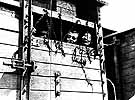
|
|
|

|

|

|

|
|
Click on an image to see a larger, more detailed picture.
|
|
|
|
|
| 1942: The "Final Solution" |

|
pg. 293 |

|
|
|
|
| |
|
|
|
|
|
|
| |
On
August 8, 1942, Dr. Gerhart Riegner, a 30-year-old refugee from Berlin, prepared an important telegraph message for Rabbi Stephen S. Wise, American Jewry's most influential leader, and Sidney Silverman, a member of the British Parliament. Based in Switzerland, Riegner represented the World Jewish Congress, an international advocacy organization that defended Jewish rights and interests. Through an anti-Nazi German industrialist named Eduard Schulte, he had received desolating information. According to Schulte's intelligence, Nazi Germany aimed to resolve once and for all the "Jewish question in Europe." This goal required the deportation of 3.5 to four million Jews to the East, where they would be "at one blow exterminated." Furthermore, Schulte's report indicated that "prussic acid" might be used to gas the victims. These actions were "planned for autumn." The terse telegraphic text that Riegner wrote to convey Schulte's testimony ended with two brief points: Riegner was relaying this information "with all necessary reservation as exactitude cannot be controlled by us," but his intelligence source was considered to have "close connections with highest German authorities" and should be viewed as reliable. Wartime secrecy required Riegner's message to go through government channels. Thus, on August 8 he contacted Howard Elting, an official at the American consulate in Geneva. Riegner made three requests. In addition to sending his message to Rabbi Wise, he wanted the American and other Allied governments to be informed of its contents, and he also urged, as Elting's summary of their conversation indicates, that "they be asked to try by every means to obtain confirmation or denial" of Riegner's information. With Elting confirming his good opinion of Riegner's seriousness and reliability, the "Riegner Cable" went to the U.S. State Department. Owing to what the State Department called "the fantastic nature of the allegation," Riegner's message was not delivered to Rabbi Wise, who nevertheless learned of its contents at the end of August. Yet not until November--after the State Department had confirmed the Riegner Cable's information--could Wise break the news to the media, which he did. By that time, however, 1942--the deadliest year of the Holocaust--had claimed most of its human toll
|

|

|

|

|
|

Anxious faces peer through a train window as they await deportation from Westerbork, Holland.
Photo: Bildarchiv Preussischer Kulturbesitz
|
|
|
|
|
| 1942: The "Final Solution" |

|
pg. 293 |

|
|
The Holocaust Chronicle
© 2009 Publications International, Ltd.
|
|
